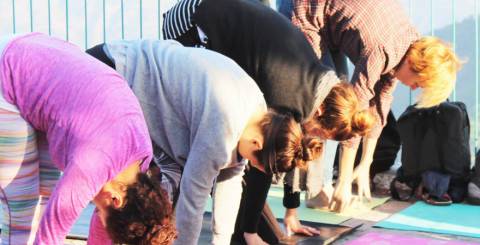Discover and try a few of these great yoga asanas (poses/postures) anytime you need to activate your brain power, sharpen your memory, and intensify concentration of the mind.
The brain in anatomical terms is a muscle and like other muscles within the body, we need to exercise them in order to perform better.
This selection of poses provides methods for activating the physical aspect of the brain, resulting in intellectual stimulation.
Modern life is believed to be causing adverse effects and mental dysfunction through increasing stress and anxiety levels. To reverse these symptoms and physical discomfort all at once, you can perform yoga poses.
Besides maintaining a healthy way of life, the correct diet, and meditation, light exercise along with yoga poses will undoubtedly keep your brain focused and effective. The additional difficulties that accompany a stressed mind, for example headaches, insomnia or depression, may find relief with effective yoga.
To calm your body and energize your mind – thereby increasing your mental power – use these essential yoga postures;
Padmasana – Lotus pose
Lotus is one of the most easily recognized poses symbolising yoga peace. The depiction of the lotus stands for unwavering strength and gentleness similar to the flower which floats on a water surface, deeply rooted while unwavering in beauty and determination. This posture embodies simplicity and facilitates relief for muscle tension and brings calm to the mind. With enhanced calm and focus, comes improved brain functioning.
This position could be incorporated into your regular exercise schedule as an effective asana for brain memory. Here is the method to perform Padmasana:
- Sitting on your mat or the ground, maintain a straight back with legs extended out in front of you
- Advanced: Bend your left knee and place your left toes onto the right thigh (upper thigh if possible).Then bend the right knee and place the right toes onto your left thigh with the soles of your feet facing upwards.
Option: If this is too extreme or painful, it is ok to place your foot onto the ground like in the below image: Sukhasana – Easy pose.
- Keeping your palms on your knees facing upwards, close down the eyes and let positive energy flow through the body.
- Relax with deep breaths and be aware of your breathing ensuring it becomes slow, deep and even
- Keep a calm, steady mind, holding this position for 5 minutes, then return to relaxed breathing and a comfortable position.
Option: Sukhasana – Easy Pose
Sarvangasana – Shoulder Stand pose
This asana, best-known to boost focus and concentration, also facilitates complete chakra engagement. The chakras are energy centers located deep at the core of our body. When these axes of energies are spurred, the brain receives instant stimulation. This fantastically therapeutic yoga for brain health may keep you psychically active and switched on. Here is the method to perform Sarvangasana:
- Lie facing up in a relaxed position on your mat, back flat against the floor
- Bring your feet together, hands down by your sides
- Create a ninety degree angle with your legs by raising your feet to the ceiling, perpendicular to the body
- Bend your elbows with your palms underneath the waist and raise your waist
- Align your legs and body to form a single line and hold this position for 15 seconds to several minutes (depending on your ability)
- Return to the initial lying flat position and wait a few moments for blood flow to return to normal
Paschimottanasana – Seated Forward Bend
An asana known for its benefit to the back and the nervous system, Paschimottanasana or the seated forward bend is effective for increasing concentration and mind power. With a fresh flow of blood to the top of the head, this forward bending position, like some others, is found to possess healing qualities for acute headaches.
Include this posture in a routine designed as yoga for brain health. Here is the method to perform Paschimottanasana:
- Sit down on your mat, extending your legs forward and placing your hands down to the sides of your body.
- Straighten your back and bring your feet together as you sit in a ninety degree angle
- Next raise your arms up high and bend straight forward from your hips so that your hands reach towards your toes, head is resting on your knees, and your chest rests on your thighs (or as close as possible)
- Hold the position for a minute or two, and build up the time as you advance. Continue making an attempt to touch your toes with your hands, eventually holding the soles of your feet.
- Return to an upright seated position and rest for a few breaths.
Uttanasana – Standing Forward Bend |
Padahastasana – Hand Under Foot pose
The standing forward bend is an especially refreshing posture for packing your system with power. The bend produces currents and blood flow to the brain that acts positively upon memory and brain power. It’s an easy posture to perform which is suitable for all levels and people aiming to extend cerebral ability with yoga for brain power.
Here is the method to perform Uttanasana, and also the Advanced: Padahastasana:
- Stand tall and upright with your feet together and hands down by your sides
- Raise up the hands to the ceiling to prepare to bend forward. Take a deep breath in and bend over keeping your legs straight and bringing your hands as close as you can to touching the ground (beginner: Uttanasana)
- When possible, place your palms beneath the feet (advanced: Padahastasana)
- Hold as long as is comfortable, suggested 1-3 minutes, then slowly return to the initial standing position. Allow the blood flow to return to normal and the energy to return to the brain. Breathe and relax.
Halasana – Plow pose
With yoga, you can create positive effects on multiple bodily systems simultaneously. Halasana, the plow pose with its forceful bend is an excellent posture to affect upon your nervous and lymphatic systems. It is also effective for relieving the mind from stress, restoring calm and peace to the body and .
Here is the method to perform Halasana:
- Lie on the mat on your back, legs are straight with your feet resting together
- Leave the arms lying straight besides the your body
- Raise your legs straight up to the ceiling to form a ninety degree angle
- Bend your elbows and place your palms flat on the back of your hips
- Using the support from the palms on the lower back, raise your legs so that your feet come over your head
- Touch the ground with your toes if they can but do not force them. Concentrate on keeping your legs almost straight and allow gravity to lower the feet slowly behind you
- Once you no longer need the support of your hands to stay up, lower your arms to the ground, palms down
- Hold this posture for as long as you can do so without straining, a number of seconds to a minute
- Slowly unroll to a flat lying position
These postures can be better performed with professional assistance and guided breath coordination with each movement. Also, a safe use of props is suggested for the more difficult postures.
Now that you have activated your full mind potential, share them with your colleagues and friends!
More in this Series:
Icons credit: monkik















